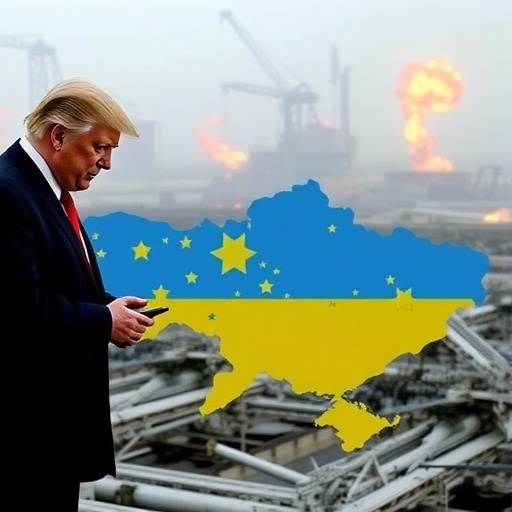Trump Administration Hits Russian Oil Giants with Crushing Sanctions as Ukraine War Escalates
In a bold escalation of economic warfare, the Trump administration has unleashed sweeping Sanctions on Russia’s largest oil companies, aiming to choke off Moscow’s funding for the intensifying Ukraine war. Announced late Thursday, these measures target key players in Russia’s energy sector, including Rosneft and Gazprom Neft, in a direct bid to pressure President Vladimir Putin into reconsidering his military campaign. With global oil prices already volatile, this move signals a renewed aggressive stance from Washington, just as frontline battles in Ukraine claim more lives and strain international alliances.
- Rosneft and Gazprom Neft in the Crosshairs: Assets Frozen, Exports Curbed
- Putin’s Unyielding Vow: ‘We Will Not Kneel to American Blackmail’
- Energy Markets Reel: Oil Prices Spike as Traders Eye Supply Disruptions
- Trump’s High-Stakes Gamble: Draining Russia’s War Funding Through Energy Isolation
- Future Fallout: Will Sanctions Force Peace Talks or Harden Russian Resolve?
The Sanctions, detailed in a White House briefing, prohibit U.S. financial institutions from dealing with the sanctioned entities and freeze assets held in American jurisdiction. Officials estimate that these restrictions could strip billions from Russia’s annual revenue, which relies heavily on oil exports to fund its war machine. “We’re hitting them where it hurts most—their wallet,” stated a senior Trump advisor, emphasizing the administration’s commitment to supporting Ukraine without direct military involvement from U.S. troops.
This development comes amid reports of heightened Russian offensives in eastern Ukraine, where Ukrainian forces have reported repelling advances near Kharkiv. The Ukraine war, now in its third year, has already displaced millions and triggered a humanitarian crisis, making any leverage against Russia a high-stakes gamble for global stability.
Rosneft and Gazprom Neft in the Crosshairs: Assets Frozen, Exports Curbed
The crux of the new sanctions falls squarely on Russia‘s oil behemoths, with Rosneft—the country’s largest oil producer—and Gazprom Neft facing immediate and severe repercussions. Rosneft, which accounts for nearly 40% of Russia‘s crude oil output, saw its shares plummet 15% on the Moscow Exchange following the announcement. The company, already under partial Western restrictions since 2022, now confronts a full embargo on transactions involving U.S. dollars or technology, effectively isolating it from global markets.
According to energy analysts at the International Energy Agency (IEA), Rosneft exported over 2.5 million barrels per day in 2023, much of it rerouted to India and China to evade prior sanctions. The new measures, however, introduce secondary sanctions that penalize any third-party nation or firm engaging in business with these oil companies. “This is a game-changer,” said Dr. Elena Petrova, a senior fellow at the Brookings Institution. “Rosneft’s ability to pivot to non-Western buyers will be severely tested, potentially slashing their revenue by up to 30% in the coming quarters.”
Gazprom Neft, a subsidiary of the state-controlled gas giant Gazprom, isn’t spared either. Specializing in refined products and upstream exploration, the company operates in over 20 countries and has been a linchpin in Russia‘s energy diplomacy. The sanctions bar U.S. firms from providing drilling equipment or software, which could halt expansion projects in the Arctic, where Gazprom Neft holds significant reserves estimated at 1.2 billion barrels of oil equivalent.
Historical context underscores the impact: Similar sanctions in 2014 following Russia‘s annexation of Crimea led to a 20% drop in Rosneft’s market value within months. This time, with the Ukraine war raging, the stakes are exponentially higher. Kremlin insiders report internal memos warning of potential layoffs affecting 50,000 workers in the oil sector, a blow to an economy already grappling with 7.5% inflation.
- Key Targets: Rosneft (primary focus, $80 billion in annual revenue pre-sanctions)
- Gazprom Neft: Refining arm hit hardest, with exports to Europe now at risk of total cutoff
- Supporting Entities: Over 20 smaller firms and shipping companies involved in oil transport
These restrictions aren’t just financial; they’re strategic. By targeting oil companies, the Trump administration aims to disrupt Russia‘s supply chains, forcing Putin to divert resources from the battlefield to economic firefighting.
Putin’s Unyielding Vow: ‘We Will Not Kneel to American Blackmail’
From the gilded halls of the Kremlin, President Vladimir Putin responded with characteristic defiance, vowing that Russia would never yield to U.S. pressure. In a televised address hours after the sanctions were revealed, Putin acknowledged the “inevitable economic discomfort” but framed it as a test of national resilience. “The West thinks it can starve us into submission, but history shows Russia bends but does not break,” he declared, drawing parallels to Soviet-era endurance during the Cold War.
Putin’s remarks, broadcast on state media like RT and Sputnik, included pointed criticism of the Trump administration. “This is not the policy of a great power but of a bully desperate to cling to hegemony,” he said, accusing Washington of hypocrisy for its own energy dependencies. Despite the bravado, economic data paints a grimmer picture: Russia‘s central bank reported foreign exchange reserves dipping below $600 billion for the first time since 2022, partly due to war expenditures exceeding $100 billion annually.
Behind the rhetoric, Putin’s government is scrambling. Reports from Reuters indicate emergency meetings with Chinese and Indian counterparts to secure alternative oil buyers, though both nations have expressed caution about secondary sanctions. Domestically, Putin has hinted at bolstering ties with BRICS partners, potentially accelerating de-dollarization efforts. “If the U.S. wants a financial war, we’ll fight it on our terms,” echoed Foreign Minister Sergey Lavrov in a follow-up statement.
Public sentiment in Russia is mixed, with state polls showing 65% support for the war but growing concerns over rising fuel prices—already up 12% year-over-year. Dissident voices, silenced under increasing crackdowns, warn that these sanctions could fuel unrest if bread lines form, reminiscent of the 1990s economic collapse.
Energy Markets Reel: Oil Prices Spike as Traders Eye Supply Disruptions
The global energy landscape is shuddering under the weight of these sanctions, with Brent crude futures surging 8% to $92 per barrel in after-hours trading. Traders fear that Russia‘s oil companies, already operating at reduced capacity due to the Ukraine war, will flood shadow markets, depressing prices for some while inflating costs elsewhere. The IEA projects a potential shortfall of 500,000 barrels per day if Russia can’t fully redirect exports, exacerbating strains on OPEC+ quotas.
In Europe, where Russia once supplied 40% of natural gas, the ripple effects are immediate. Germany’s economy minister warned of a “harsh winter” ahead, with LNG imports from the U.S. straining port capacities. U.S. Energy Secretary Jennifer Granholm noted that American producers stand ready to fill the gap, potentially boosting domestic output by 1 million barrels daily through fracking expansions in Texas and North Dakota.
Asia, a growing haven for Russian oil, faces its own dilemmas. India’s Reliance Industries, a major buyer, issued a statement reviewing contracts amid fears of U.S. penalties. “We’re navigating uncharted waters,” said an executive anonymously. Meanwhile, Brent’s volatility has Wall Street buzzing: JPMorgan analysts forecast a 10-15% premium on global oil prices through 2025, adding $200 billion to worldwide import bills.
- Immediate Impact: Russian Urals crude traded at a $25 discount to Brent, now widening to $35
- Longer-Term: Potential for Russia to invest in domestic refining, reducing export quality
- Geopolitical Shifts: Increased U.S. LNG exports to Europe, strengthening NATO energy security
For consumers, this translates to pain at the pump: U.S. gasoline prices could climb to $4.50 per gallon by summer, per AAA estimates, fueling inflation debates ahead of midterm elections.
Trump’s High-Stakes Gamble: Draining Russia’s War Funding Through Energy Isolation
At the heart of this policy is President Trump’s vision of economic coercion as a surrogate for military action in the Ukraine war. Advisors close to the White House describe the sanctions as a “scalpel to the Kremlin’s finances,” building on earlier measures that have already cost Russia an estimated $300 billion in frozen assets. Trump himself tweeted post-announcement: “Time to make Putin pay for his aggression—America First means standing with Ukraine against tyrants.”
The strategy draws from Trump’s first-term playbook, where similar tactics pressured Iran and Venezuela. Yet, experts caution that Russia‘s oil sector, contributing 40% of federal budget revenues, is more resilient than anticipated. The Carnegie Endowment for International Peace reports that despite sanctions, Russia‘s 2023 oil income hit $180 billion, buoyed by high prices and shadowy tanker fleets.
Implementation details reveal nuance: The Treasury Department’s Office of Foreign Assets Control (OFAC) will enforce compliance through audits and fines, with initial waivers for humanitarian oil flows to avoid global food crises. Congressional support is bipartisan, with Senate Foreign Relations Chair Bob Menendez praising the move as “essential to Ukraine’s survival.” However, critics like Rep. Marjorie Taylor Greene argue it risks alienating Russia further, potentially escalating the conflict.
Broader context includes U.S. alliances: NATO partners like the UK and Canada are aligning with parallel sanctions, while the EU mulls its own expansion targeting Lukoil. This coordinated front aims to amplify pressure, but challenges persist—Russia‘s pivot to ruble-based trades with allies like Turkey complicates enforcement.
Future Fallout: Will Sanctions Force Peace Talks or Harden Russian Resolve?
As the dust settles, the world watches whether these sanctions will bend Putin’s will or steel it. Ukrainian President Volodymyr Zelenskyy hailed the measures as a “lifeline,” noting they could curtail Russian missile strikes by limiting procurement funds. Yet, intelligence sources suggest Moscow may retaliate by curbing grain exports, threatening food security in Africa and the Middle East.
Economically, the IMF warns of a 2.5% contraction in Russia‘s GDP by 2025 if oil revenues falter, possibly prompting subsidy hikes that strain the budget. For the U.S., success hinges on multilateral buy-in; failure could embolden adversaries like China, which has deepened energy ties with Russia. Trump administration officials eye diplomatic channels, hinting at backchannel talks in Geneva to test Putin’s flexibility.
In Ukraine, where daily casualties mount, these sanctions offer hope amid despair. Aid packages totaling $61 billion, recently approved by Congress, will pair with economic pressure to sustain Kyiv’s defense. As winter looms, the true test begins: Can starving Russia‘s oil companies translate to peace, or will it prolong the Ukraine war‘s agony? The coming months will reveal if Trump’s bold stroke redraws the geopolitical map or merely adds fuel to the fire.









